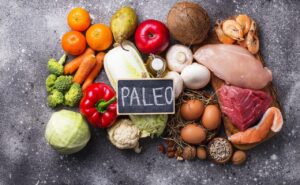Is the Paleo diet, based on the diet practiced by our Palaeolithic ancestors, applicable in the modern world? Can we arrange our meals according to people who lived thousands of years ago? Finally – is such a diet good for us?

What is the paleo diet?
The Paleo Diet, also known as the “Cavemen Diet,” is a modern attempt to recreate the diet of people from the Paleolithic Age. It was initiated in the 1970s by the gastroenterologist Walter Voegtlin, and then popularized by Dr. S. Boyd Eaton, professor of anthropology at Emory University. He believed that the human body was designed for the paleo diet. In his book, The Paleolithic Prescription, he argued that the modern diet is not serving us, so we should return to that practiced in a hunter-gatherer society (to which we have been genetically programmed) [1] . Are modern diseases the result of today’s eating habits? This opinion is shared by Eaton and the paleo dieters.
The main goal of the “caveman diet” is to return to a diet that resembles the menu of the first humans. Assuming that the human body is genetically mismatched to the modern diet that has emerged with agricultural practices, it is necessary to completely reject products that are a consequence of the transition from a hunter-gatherer lifestyle and exclude processed products from the menu. It cannot be denied that agriculture has changed the way we eat – it introduced grains, dairy products and legumes, among others. This quick change of diet by. experts outstripped the body’s ability to adapt. Therefore, we struggle with obesity, diabetes and heart disease.
What to eat and what to avoid?
Products similar to the nutritional model of our ancestors:
- Fruits and vegetables
- Nuts and seeds
- Meat: poultry (turkey, chicken, goose, duck), lean beef, offal, hare, rabbit, lamb, venison
- Seafood
- Fish: salmon, tuna, trout, halibut, cod, flounder, sole, herring, sardine
- Eggs
- Healthy vegetable fats: coconut oil, linseed oil, avocado oil, nut and seed oils, olive oil)
Products to Avoid:
- Highly processed food
- Cereals: wheat, spelled, rye, rice, groats
- Refined sugars
- Legumes (beans, lentils, peas, chickpeas)
- Dairy
- Vegetables containing starch
Sample menu
If you want to test whether the paleo diet is right for you, try the following meal suggestions:
BREAKFAST (option 1)
Eggs fried in coconut oil
BREAKFAST (option 2)
Pancakes with a banana and 2 eggs fried in coconut oil
BREAKFAST (option 3)
Spinach smoothie with half a banana and ginger
BREAKFAST (option 4)
Egg baked in avocado
BREAKFAST (option 5)
Fruit salad (apple, banana, plum, strawberries)
LUNCH (option 1)
Salad with tomato, cucumber, chicken, and olive oil
LUNCH (option 2)
Oyster mushrooms with garlic, sprinkled with parsley, fried in olive oil
LUNCH (option 3)
Shrimps fried with garlic in olive oil
LUNCH (option 4)
Baked chicken with asparagus
LUNCH (option 5)
Cod baked in tomatoes
DINNER (option 1)
Baked vegetable fries (carrots, zucchini, parsley)
DINNER (option 2)
Tuna carpaccio
DINNER (option 3)
Hard-boiled eggs + vegetables
DINNER (option 4)
Avocado, tomato, cucumber and romaine salad with chili and linseed oil
DINNER (option 5)
Baked salmon with spinach and cherry tomatoes
The pros and cons of the paleo diet
The paleo diet has many positive sides and for many people it can be a fantastic solution – it is based on unprocessed products, and is also devoid of unnecessary preservatives and salt (thanks to which it can prevent many civilization diseases). Among the benefits of the “caveman diet”, researchers mention: weight loss, regulation of lipid and insulin metabolism, improvement of glucose tolerance, and improvement of risk factors for cardiovascular diseases [2]. On the other hand, there are also critical voices relating to the paleo diet, such as: unnecessary elimination of dairy products (which may contribute to the occurrence of calcium and protein deficiencies) and fiber-rich foods (groats, whole wheat bread), which improve bowel function and prevent constipation . It should also be borne in mind that this is an expensive diet, often requiring self-preparation of meals. In addition, there are questions about the paleo diet hypothesis. Scientists argue that the differences in the diets of our Paleolithic ancestors may have been due to a number of factors, including geographic location, climate and food availability – so can we be sure that our modern menu corresponds to thousands of years ago?
[1] https://www.livescience.com/53368-paleo-diet.html
[2] https://www.healthline.com/nutrition/5-studies-on-the-paleo-diet#the-studies






Leave A Comment
You must be logged in to post a comment.